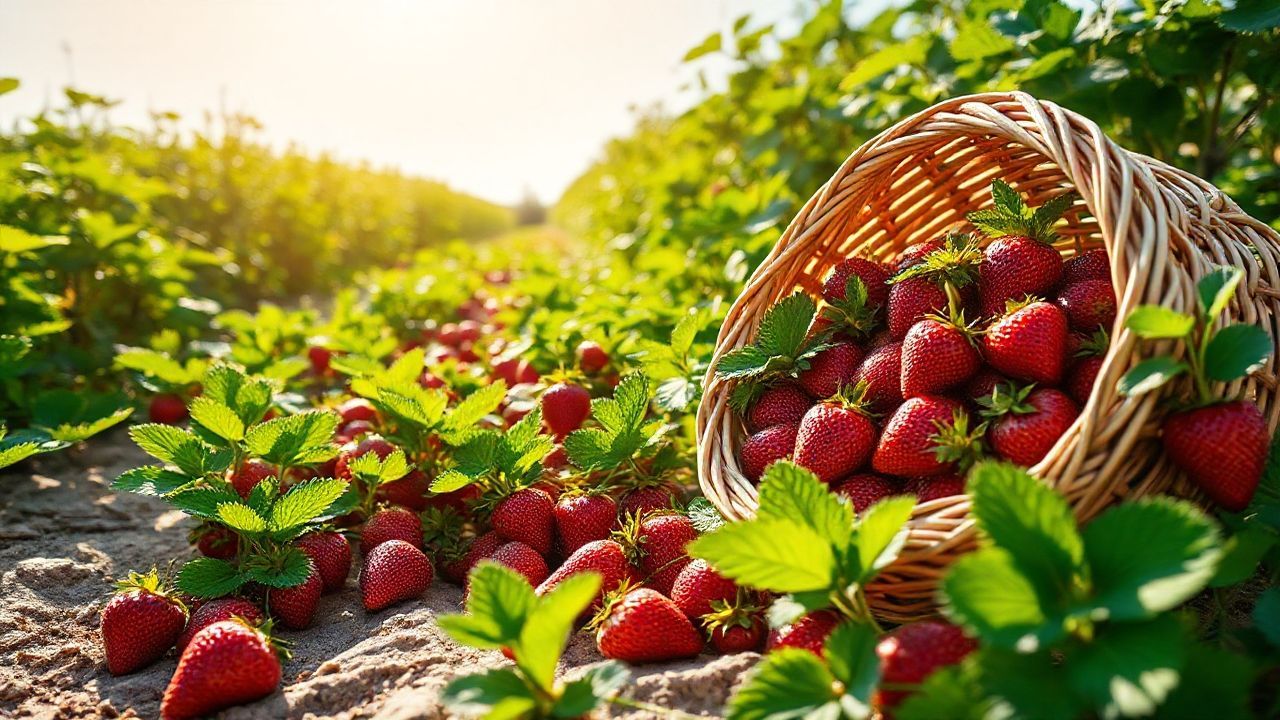Introduction to strawberries
Strawberries, the epitome of summer fruits, tantalize our taste buds with their vibrant red hue, juicy sweetness, and refreshing aroma. Their seasonality, however, varies significantly across regions, making it crucial to know when to expect these delectable berries at their peak. Understanding the factors influencing their growth and development allows us to pinpoint the optimal time to savor the freshest and most flavorful strawberries.
Temperature plays a pivotal role in strawberry production. These plants thrive in cool, temperate climates and require consistent temperatures between 40 and 80 degrees Fahrenheit. Warmer temperatures accelerate ripening, while cooler temperatures prolong it. Additionally, strawberries are sensitive to frost, which can damage or kill the plants.
Daylight length is another significant factor affecting strawberry production. As day length increases, the plants produce more flowers and subsequently more berries. In regions with longer days, the strawberry season tends to be earlier.
Soil conditions also influence strawberry growth. Well-drained, fertile soil rich in organic matter provides an ideal environment for the plants to flourish. Raised beds or rows can help improve drainage and prevent waterlogging, which can lead to root rot.
With these factors in mind, let’s explore the typical strawberry seasons in different parts of the world:
Global strawberry season overview
The peak of the strawberry season is typically in June, when the berries are at their sweetest and most flavorful. However, you can find strawberries in stores and farmers markets throughout the season. When choosing strawberries, look for berries that are bright red and have a fresh, slightly sweet smell. Avoid berries that are bruised or have any signs of mold.
Strawberries can be enjoyed in a variety of ways. They can be eaten fresh, added to salads or desserts, or used in smoothies or juices. Strawberries can also be cooked into preserves, jams, and pies. No matter how you choose to enjoy them, strawberries are a delicious and healthy fruit that can be enjoyed by people of all ages.
Seasonal differences by region
The exact timing of strawberry season can vary significantly depending on your region. In warmer climates, such as California and Florida, strawberries may begin to ripen as early as December or January. In cooler regions, such as Maine or Alaska, the season may not start until June or July. These regional variations are primarily driven by temperature and sunlight. Strawberries thrive in warm, sunny conditions, and their ripening process slows down or stalls completely in cooler temperatures.
California: The strawberry season in California typically lasts from March to November, with the peak season occurring in May and June. The state’s warm climate and abundant sunlight create ideal conditions for strawberry production, making California one of the leading strawberry-growing regions in the world.
Florida: Florida’s strawberry season runs from December to May, with the peak season occurring in March and April. The state’s mild winters and warm spring temperatures allow strawberries to ripen earlier than in many other parts of the country.
North Carolina: In North Carolina, the strawberry season typically begins in April and lasts until June. The state’s warm climate and ample rainfall provide favorable conditions for strawberry production, making North Carolina one of the top strawberry-growing states in the eastern United States.
Oregon: Oregon’s strawberry season generally runs from June to September, with the peak season occurring in July and August. The state’s mild climate and long daylight hours create optimal conditions for strawberry production in the summer months.
Washington: Washington’s strawberry season typically begins in June and lasts until September. The state’s cool, rainy climate is not ideal for strawberries, but growers have developed techniques to cultivate them successfully in the Pacific Northwest.
How to identify ripe strawberries
Color: Ripe strawberries boast a vibrant, deep red hue with a consistent shade throughout. Avoid berries with any green or white patches, as they indicate under-ripeness or bruising.
Texture: Firmness is paramount. Gently press the strawberry; it should give slightly under pressure, but not be too soft or mushy. Overly soft berries may be bruised or spoiled.
Aroma: Ripe strawberries exude an irresistible, sweet, fruity fragrance. If the berry has minimal aroma, it’s likely unripe or has lost its freshness.
Shape and Size: While size can vary, look for plump, symmetrical berries. Avoid berries with misshapen contours or bruises.
Shine: A slight sheen on the surface of the strawberry is another sign of ripeness. Overly dull berries may be past their prime.
By following these simple guidelines, you can easily identify ripe strawberries and savor their unparalleled flavor and nutritional benefits. Remember, the best way to experience the true essence of this beloved fruit is to indulge in locally grown, freshly picked berries during their peak season.
Tips for growing and picking strawberries
Conclusion: Enjoy the best of strawberry season
Each bite of a ripe strawberry is a symphony of flavors, its delicate flesh yielding to reveal a burst of tantalizing juices. The sweetness lingers on the palate, leaving a trail of fruity ecstasy. Whether enjoyed fresh from the vine, incorporated into delectable desserts, or transformed into refreshing beverages, strawberries embody the essence of summer’s bounty.
Indulge in the fleeting pleasure of strawberry season by incorporating these vibrant berries into your culinary repertoire. Their versatility knows no bounds, from classic strawberry shortcake to innovative salads and savory dishes. Each creation becomes a canvas upon which the strawberry’s vibrant hues and delectable flavor can dance.
So, as the sun shines brightly and the air fills with the sweet scent of strawberries, seize the opportunity to savor this seasonal treasure. Embrace the joy of picking fresh berries, delight in their vibrant colors, and immerse yourself in the pure indulgence of their irresistible taste. Let strawberry season be a time to celebrate the abundance of nature’s gifts and the simple pleasures that make life truly sweet.

Leave a Reply